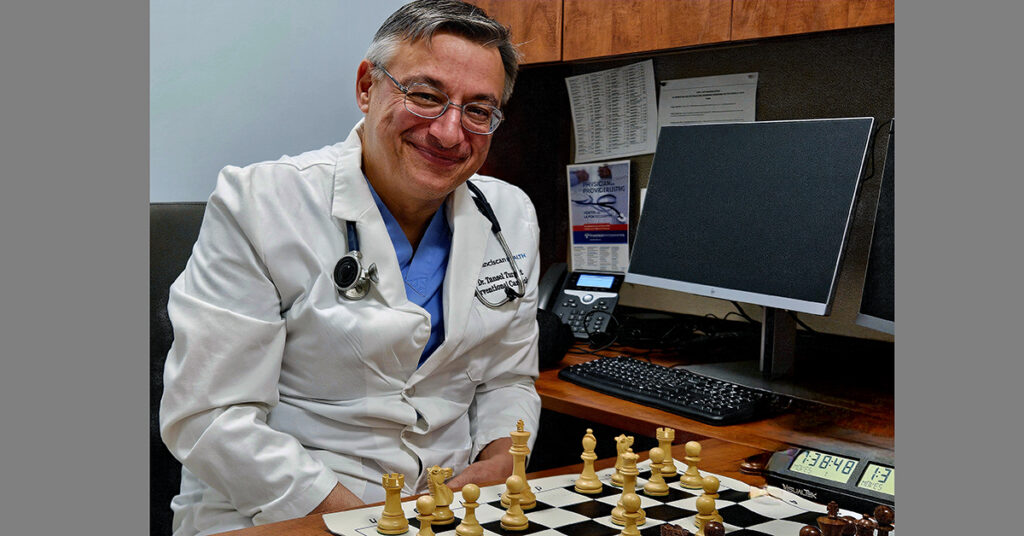Advances in medical technology improve outcomes, and careers, too.
by Bob Kronemyer
Whether it's electromagnetic guidance to detect lung cancer or robotic-assisted surgery for removing a gallbladder, the region's health care centers are committed to offering their patients the newest in clinically proven diagnostics and treatment. High-tech options are also fueling select job growth within the industry.
At Gary-based Methodist Hospitals, a new diagnostic tool for detecting lung cancer allows clinicians to more precisely locate a lesion (spot) and perform a biopsy, if needed, to determine if the lesion is cancerous or not. Electromagnetic navigation bronchoscopy (ENB) is a follow-up procedure to a CAT scan, normally scheduled one week later.
“In the past, we always performed a bronchoscopy with a flexible bronchoscope,” says Dr. Hakam Safadi, medical director of respiratory and intensive care. “However, the flexible bronchoscope has its limitations, such as how deep it can enter the lung. The flexible bronchoscope can extend only as far as the center of the lung. Lesions located in peripheral areas (outer edges) of the lung cannot be detected.”
In contrast, ENB is able to reach peripheral lesions with the help of a special catheter that is inserted through the bronchoscope and GPS-like technology that guides the clinician to a specific lesion previously identified by CAT scan. Fine-needle aspiration biopsy can also be performed from the inside of the body during the same procedure, as opposed to entering from the chest wall, which carries a high risk of a collapsed lung.
Methodist Hospitals began offering ENB in August at its Merrillville campus, which takes about 90 minutes to perform in an outpatient setting. Patients are either asleep or under heavy sedation “for no discomfort at all,” Safadi says. Following ENB, patients have an x-ray taken for confirmation. In total, patients should allow about four hours and can resume daily activities immediately.
Candidates are those who either have a peripheral lung nodule (spot), or have had previous cancer of the lung but now have a lesion. ENB can also assist surgeons performing a video-assisted thoracoscopy to remove a lung nodule, by marking the nodule in advance.
The supply of current physicians is unable to keep up with the demand for quality health care, Safadi observes. “Family practice and nearly all specialties are needed, including my own of pulmonary and critical care,” he says. “The only specialty where the number of procedures is declining is cardiovascular.”
Last December, Memorial Hospital of South Bend started offering low-dose computerized tomography (CT) scanning. “Medical radiation accounts for about 50 percent of the total radiation in the United States today, and CT is the largest portion of that medical radiation,” says Derek Taylor, director of diagnostic imaging. “On average, we've seen about a 40 percent reduction in radiation exposure with the new low-dose upgrade.”
CT scanning is commonly used in emergency situations (e.g., ruptured appendix) and among newly diagnosed cancer patients. “Some patients may need multiple scans over time, so low dose is very appealing to them,” Taylor says.
All three of Memorial Hospital's CT scanners (two upgraded and one replaced) on campus now employ low dose. “Being able to lower the radiation dose to the population that we serve truly aligns with our value of safety at the hospital, and provides value to our community,” Taylor says. “Any time a patient has to undergo a medical procedure that uses ionizing radiation, there is a cumulative dose effect that needs to be taken into consideration. The more we can lower that dose, the better it is for the patient who may need a CT scan.”
Taylor points out that low-dose CT scanning can change the risk-benefit equation for physicians. “Clinicians should be less worried about any potential radiation risks when ordering a CT scan,” he says.
Job growth in health care will be spurred in part by an increase in chronic conditions among aging baby boomers, which makes radiology (imaging) a smart career choice, according to Taylor. “And low dose can only help to make CT a more appealing image option in the future,” he says.
The RIO Robotic Arm Interactive Orthopedic System at St. Joseph Regional Medical Center in Mishawaka allows accurate alignment and positioning of hip and knee implants.
“Statistically, this system is four times more accurate than a surgeon's own eyes or hands,” says orthopedic surgeon Dr. Fred Ferlic, who uses the robotic arm for total hip and partial knee. “After a CT scan, I am able to calibrate the exact angle to cut bone; for example at 45 degrees. Every patient is different.” After Ferlic opens the wound, the computer program guides the RIO to lock the saw at the desired angle.
A study conducted at Massachusetts General Hospital in Boston found that 50 percent of artificial hip sockets were implanted out of the safe zone. “The RIO eliminates all that human error,” says Ferlic, who last October became the first surgeon to use the RIO in Indiana and to date has treated over 100 knees and hips. “Clinical outcomes are improved because the chance of an implant becoming dislodged over time is greatly reduced. There is also less blood loss because placement is precise.”
Ferlic recommends that those starting out in health care should embrace technologic advancements such as the RIO, or pursue biomedical engineering or stem cell research.
“In 20 or 30 years, we will no longer be doing total knee or total hip,” Ferlic predicts. “Instead, a patient will come into the office and have a polymer injected that will cure into a piece of rubber lasting a few years. It will be like changing a tire every so often.”
The daVinci Surgical System for robotic-assisted minimally invasive surgery is now being used to perform gallbladder removal in conjunction with single-incision laparoscopic surgery (SILS) at Community Hospital in Munster.
“Instead of having three or four smaller incisions, we make a single slightly larger incision to accommodate the camera and all instrumentation,” explains Dr. M. Nabil Shabeeb, medical director of robotic surgery at the hospital. By using the daVinci system, there is 3-D visualization of the operating field via the tiny camera, plus the instrumentation, which is surgeon-operated, robot-driven “for detailed view and tremendous versatility of movement within the abdomen.”
Shabeeb, who in March became the first surgeon in Indiana to use SILS for gallbladder removal, usually sits at a console in the same room as the patient on the operating table.
The procedure offers a cosmetic advantage because of the single incision that measures only slightly over one inch. “We can also usually hide about half of the incision in the navel for less visibility,” Shabeeb says. Moreover, “there is more comfort, and the hospital recovery is often reduced from six to four hours compared to multiple-incision laparoscopy.” Also, fewer patients require an overnight stay.
As for job prospects in health care, Shabeeb observes a growing shortage in physicians in several specialties, which is being augmented by physician assistants, clinical nurse specialists and nurse practitioners. “We are seeing teams of physicians and intermediate-care professionals working together at hospitals or the outpatient setting,” he says.
Cancer patients at Mishawaka-based Franciscan Alliance now have the option of being treated with the Trilogy radiation delivery system at the Burrell Cancer Center in Crown Point and the Woodland Cancer Center in Michigan City. During the roughly eight-minute procedure, the patient lies on a table, during which time part of the system rotates above the patient and below the patient to deliver potent, dual (superficial and deep) photon radiation.
Cancers frequently treated with the Trilogy are prostate, head and neck, and breast.
Patients schedule four to six sessions, and there is no discomfort. “Compared to conventional treatment, the Trilogy provides pinpoint accuracy and isolated treatment to just the lesion itself, so it minimizes any dose effect to normal tissue,” says Michael Budimir, regional director of imaging services. Treatment time is also cut in half. Still, patients may experience cumulative side effects, such as nausea and erythema (skin turning red).
The Trilogy also features imaging technology similar to a CT scan. “We feel clinical outcomes will improve and, in some cases, the number of treatment sessions is reduced,” Budimir notes.
Budimir singles out nursing and nurse practitioners for job growth, in part because of the increasing number of people in need of health care. Further, “with an aging population, we are seeing more chronic healthcare needs,” he says. Allied health fields such as respiratory therapy and radiologic technology hold particular promise.
Cardiac intervention has particularly advanced at the new Porter Regional Hospital in Valparaiso, starting with paramedics arriving at the home of a person complaining of chest pain, for example.
“We now have the capability of performing an electrocardiogram right in the caller's home that records the heart's electrical activity,” says Mark Kime, director of cardiology at the hospital. “The person may be at the beginning or in the middle of a heart attack.” And from the field, the paramedics can transmit an electrocardiogram directly into the emergency department, setting off a general call so that a team of doctors, nurses and technicians from the interventional cath lab can already be assembled by the time the patient arrives at the hospital.
Cardiac intervention is a general term given to procedures that open or repair arteries of the heart to minimize cardiac muscle damage if the patient is having a heart attack, or prevent a heart attack from occurring at all. “The national goal is 90 minutes from the time a patient arrives at the hospital to the beginning of cardiac intervention,” Kime states. “At Porter, we are actually at 78 minutes, so we are ahead of the curve.”
Today, the physician typically inserts a catheter through a smaller artery in the arm instead of the groin, and into the heart. Then, by using fluoroscopy (imaging) and a radiopaque dye (a contrast material), the physician can pinpoint the exact location of the narrowing of the arteries. “An acute lesion may be starving the heart for oxygen and nutrients causing muscle damage,” Kime says. If indicated, coronary angioplasty is next performed, whereby a tiny deflated balloon wrapped snuggly around a catheter is inflated in the narrowest part of the lesion in order to push the space open.
However, this is only a temporary solution, immediately followed by the introduction of a second catheter and a second balloon and a stent (a small expandable metal tube) that bridges the entire narrowing. “When the balloon is inflated, the plaque that is blocking the artery is compressed, so that a nice wide pathway is created through that stent,” Kline explains. “Over time, the body grows into that and almost becomes natural tissue.”
Cardiac intervention has become so prevalent at Porter Regional Hospital that the new facility has four interventional labs, compared to only two at the old hospital.
Kime points out that in the critical care realm, nursing has the brightest future. “It is generally projected that over half of the 600,000 new nursing positions to be created nationwide by 2016 will be in critical care,” he says. “Add to this the untold number of nurses retiring and there is an impressive outlook.” Other promising careers include cardiac sonographer, cardiovascular technician, medical information, health administration and emergency medical technician.


